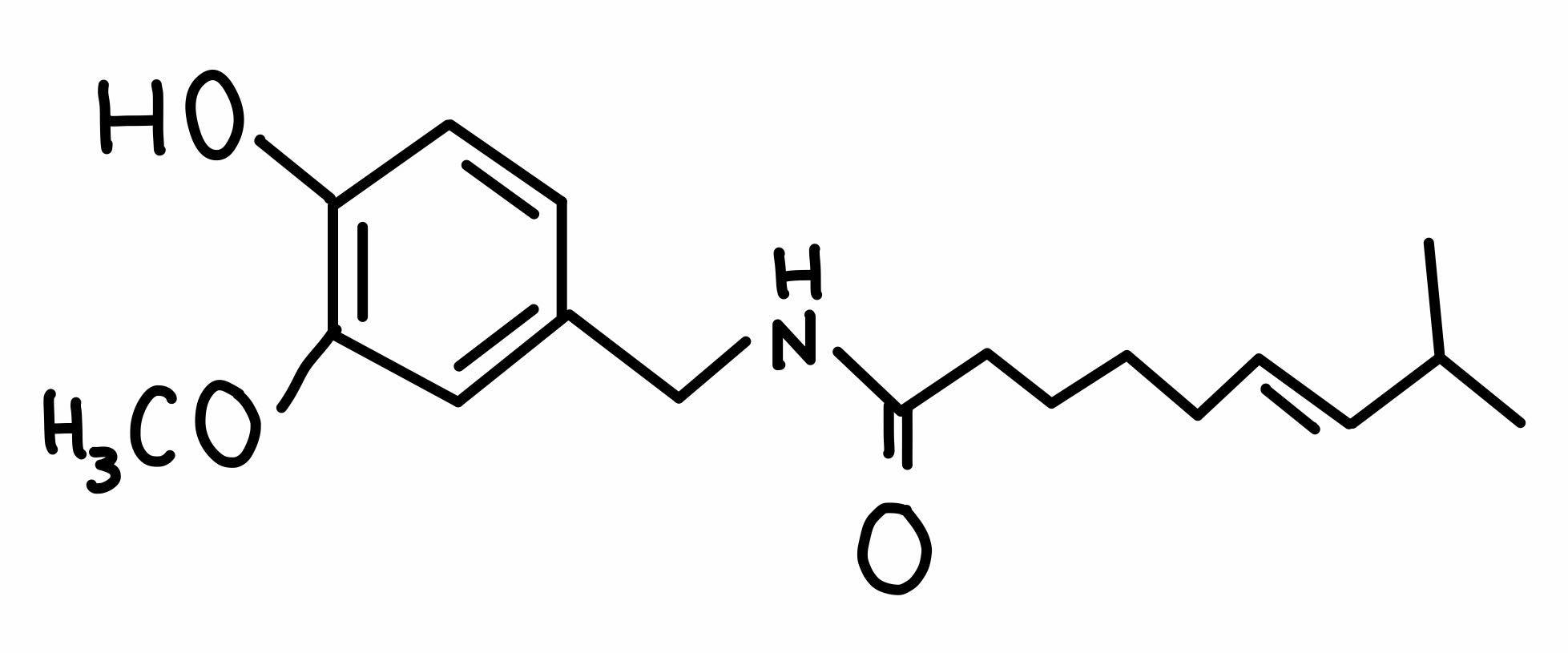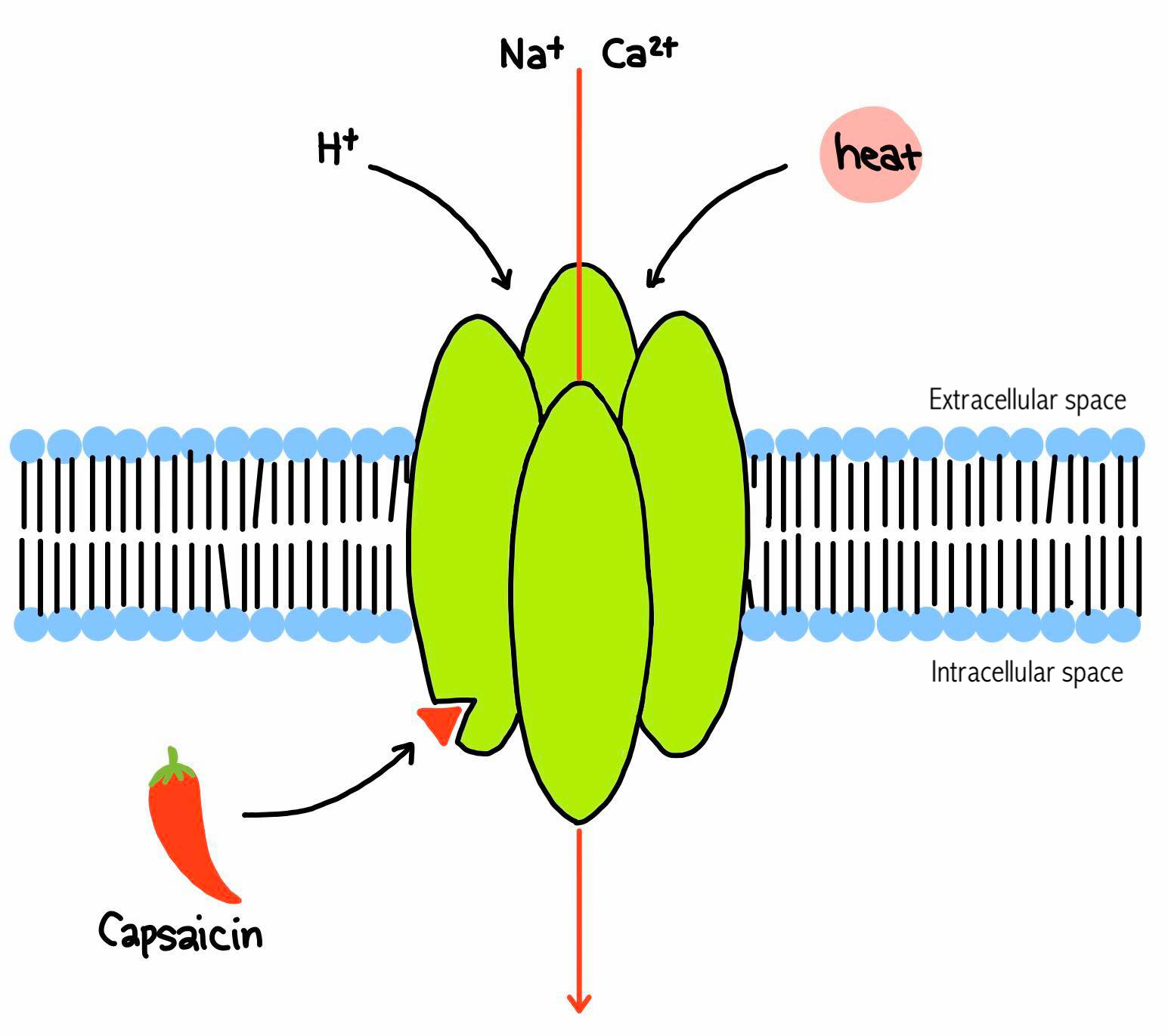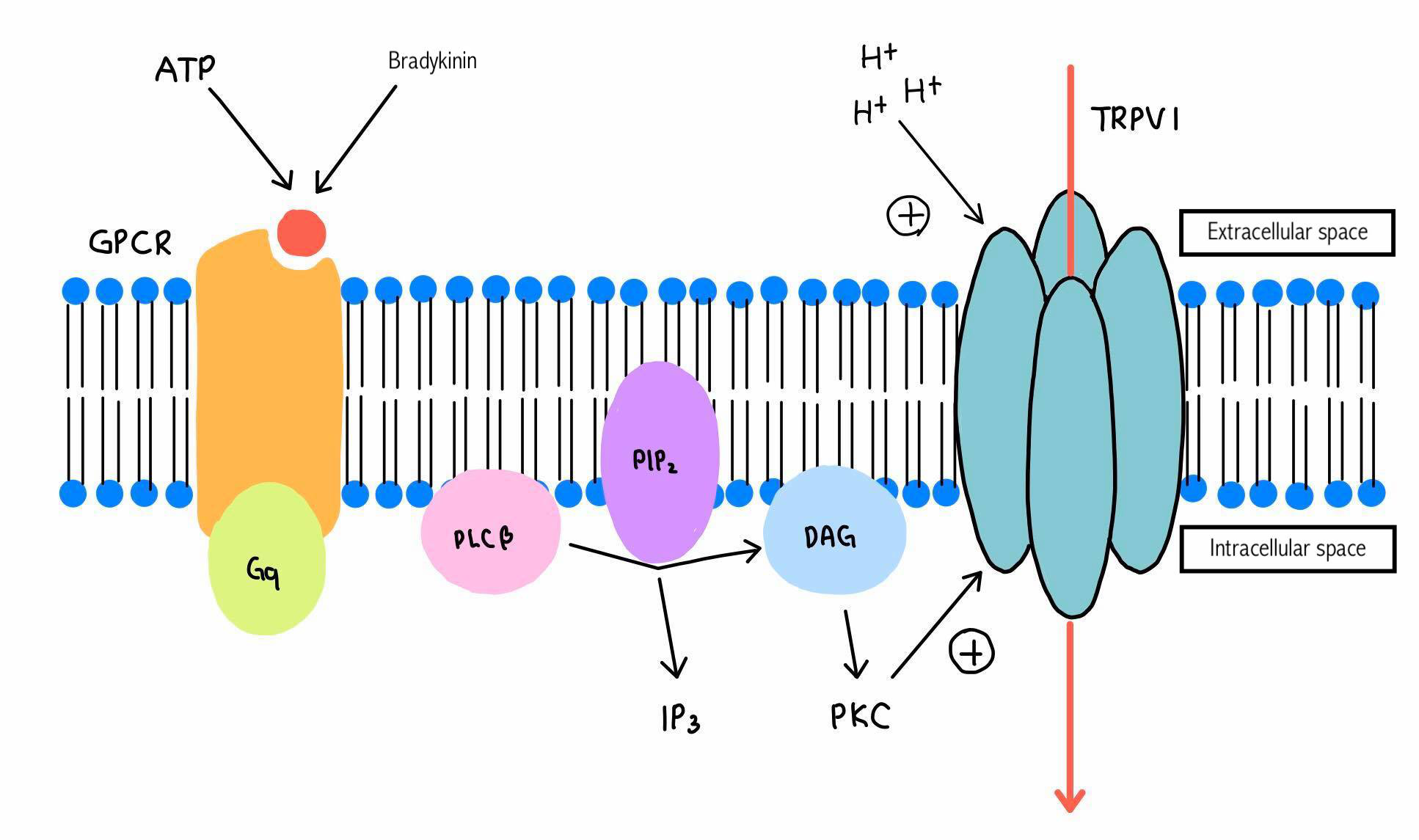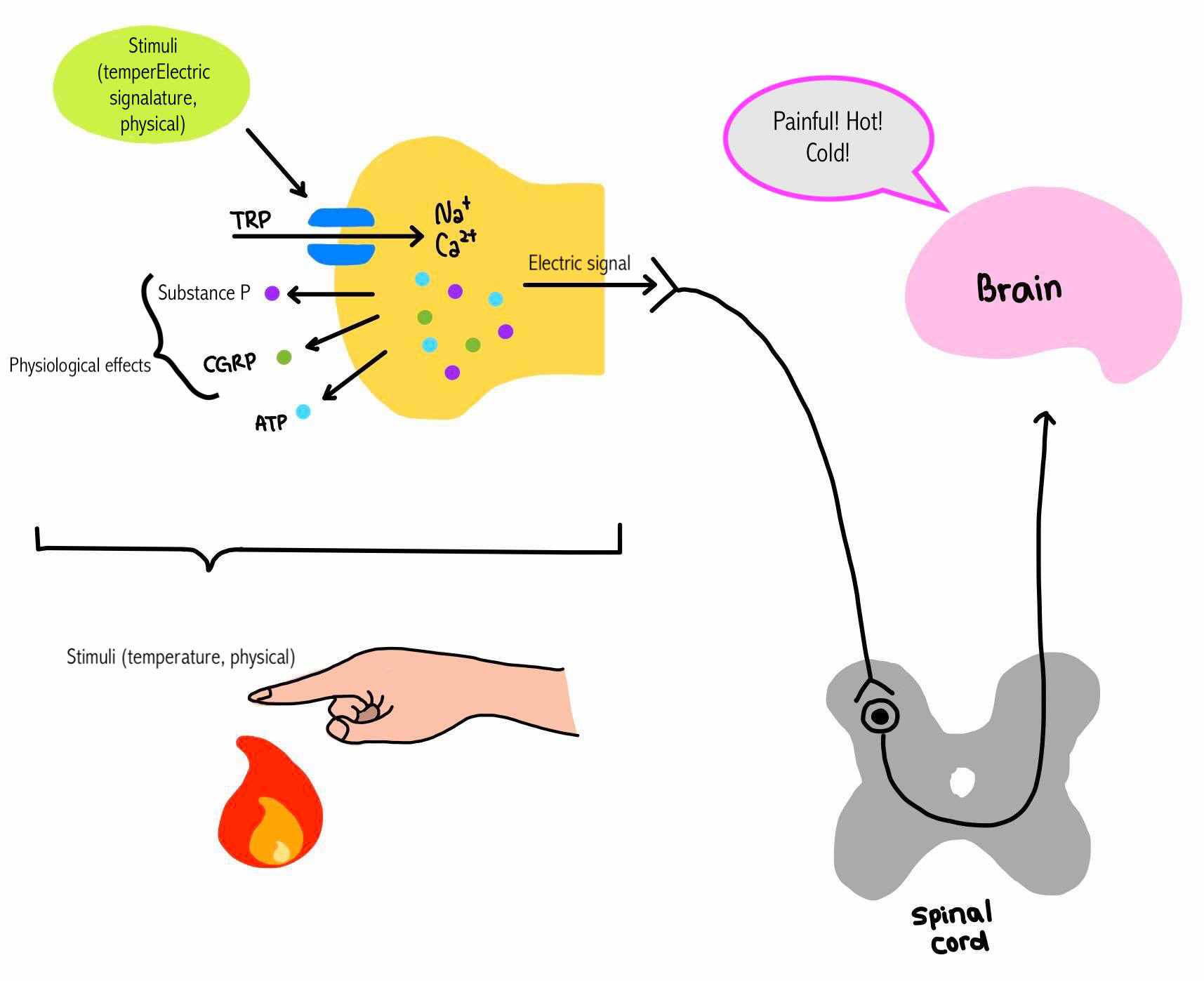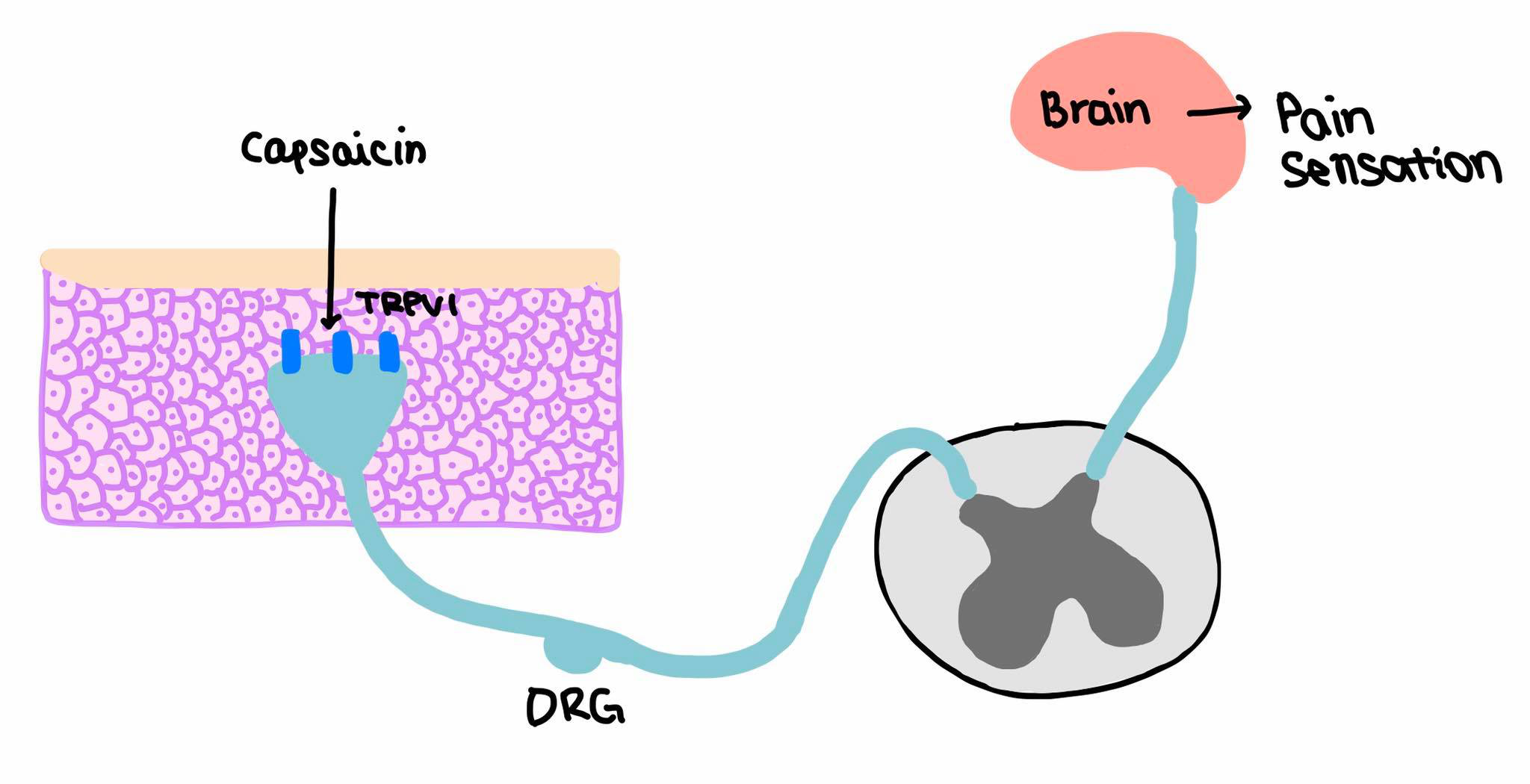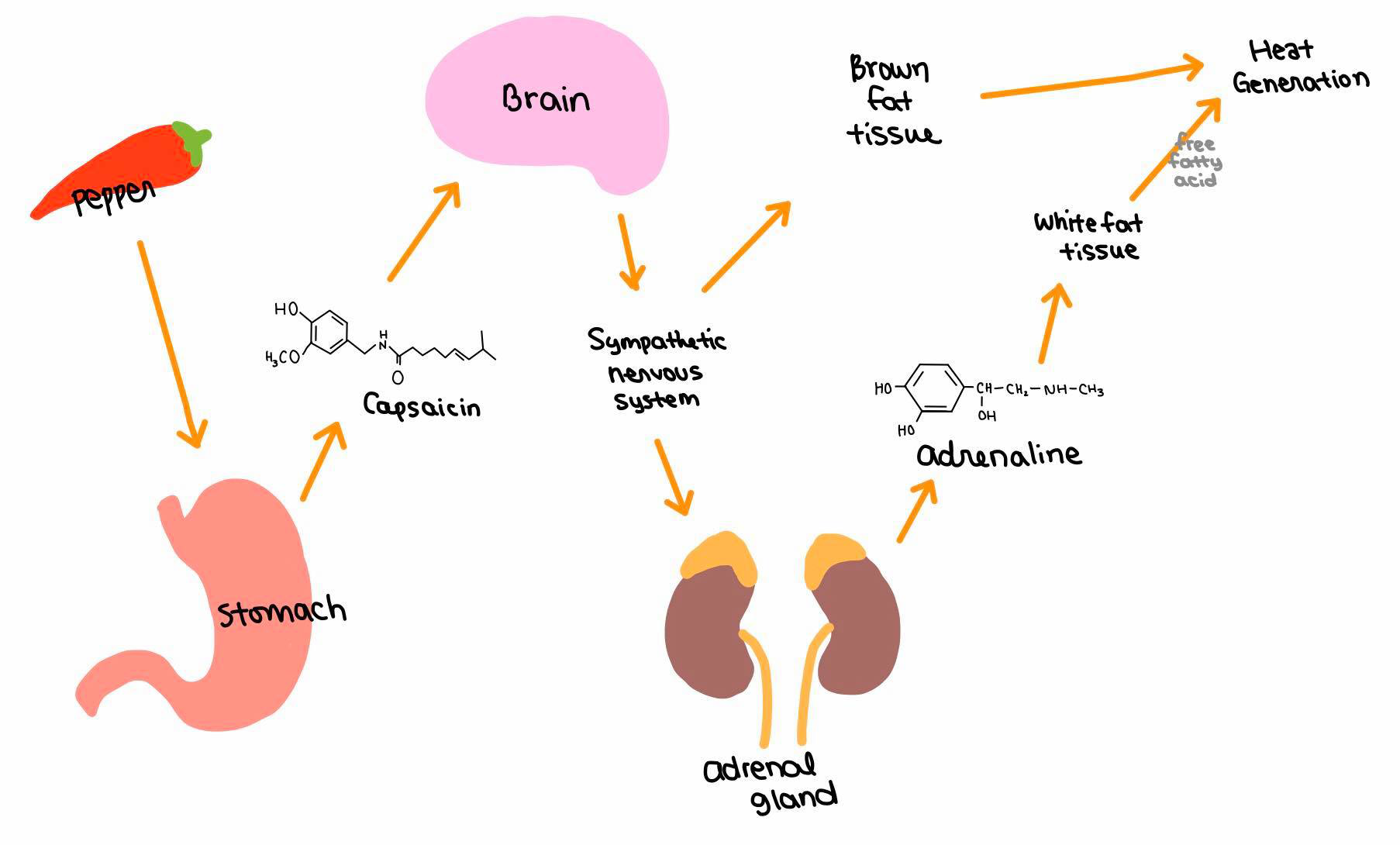Contents
PHYSIOLOGICAL EFFECTS OF CAPSAICIN
Introduction
Have you heard of ‘mukbang’? It is a new trend that is popular among those who create their own YouTube videos. It means broadcasting yourself eating. This is becoming an increasingly popular trend and lots of people watch this. If you search the word mukbang on YouTube, you may find lots of videos people eating many kinds of food. As you scroll down the video list, you will see a variety of foods that are eaten include ‘artificially made spicy’ ingredients. Furthermore, there were YouTube challenges called ‘fire noodle challenge’, or ‘one chip challenge’, which entail eating spicy food and showing people how they react. Why are the people obsessed with these spicy foods? What kinds of chemicals are used to make the food artificially spicy?
Why are people more and more obsessed with spicy food?
'Spicy’ is not a taste. It is the tongue feeling pain when a compound that makes you feel spicy sensation attaches to the surface of the tongue. To lessen the pain, the brain secretes endorphins, which has analgesic effect. Endorphins not only have painkiller effects, but also make people feel happy. This, in effect, lessens stress so people are obsessed with the so-called 'spicy' feeling!
What is capsaicin?
|
Figure 1 'Chemical structure of capsaicin' |
- C18H27NO3 (Figure 1)
- 8-methyl-N-vanillyl-6-nonemnamide
- Alkaloid family
- Derived from the genus Capsicum
- Hydrophobic
- Colourless and odourless
- It is a compound found in chilli pepper.
- Found both in the seed and skin, but contained a lot in the seed. o To protect itself from other animals or plants o to propagate by spreading the seed
- For those animals that capsaicin is not toxic for themselves : chilli pepper seed is one of the good food for them
- For those animals that capsaicin is toxic for themselves : they avoid eating chilli pepper
- Found both in the seed and skin, but contained a lot in the seed. o To protect itself from other animals or plants o to propagate by spreading the seed
- Is used for medicine and spices
- It makes mucous membranes in the mouth feel burning sensations. ( affecting nociceptor )
- Compounds that are related to capsaicin are called ‘capsaicinoid’.
- This is 2nd metabolites produced by chilli pepper.
(Cordell et al., 1993)
Effect of capsaicin
- Promotes appetite (Yun et al., 2003)
- Accelerates metabolism → burns fat → prevents body from storing fat (Kang et al., 2010)
- Analgesic → is used in painkillers (Yaksh et al., 1979)
- Recently, it has been revealed that capsaicin has an anti-cancer effect (Munkyeong, 2012)
- Makes adrenaline secretion more active from adrenal medulla (Negulesco, 1985)
- Sterilizing effect
- Raises body temperature (Yun et al., 2003)
- Decreases blood cholesterol level → can be adequate for remedies of arteriosclerosis or diabetes mellitus (Negulesco, 1985)
- Recovering fatigue (Satyanarayana, 2004)
- Because chilli pepper contains vitamin A, B, and C, it is good for recovering fatigue.
- Specifically, it has 9 times more vitamin C than a tangerine (mandarin), 18 times more than an apple.
- Increases immunity (Deng et al., 2016)
- Chilli pepper contains B-carotene, which is converted into vitamin A.
- Vitamin A increases immunity and prevents from nyctalopia.
Disadvantages of capsaicin
- Having too much spicy food can harm your health
- Potential for damage of the mucous layer of stomach (Satyanarayana, 2006)
- Wall of stomach becomes thinner (Satyanarayana, 2006)
- Stomach ulcer or chronic gastritis can occur (Satyanarayana, 2006)
- Can cause skin irritation
- Bad for people who have acne or face redness (flashes)
- This is because
- Capsaicin activates sympathetic n. → heart beats faster
- Capsaicin causes people to sweat → dilates blood vessel
- Disturbs deep sleep (REM cycles) (Obál et al., 1983)
- Stomach-ache (Hutchinson et al., 1990)
- Feeling burning sensation in the stomach
- More general to people who have irritable bowel syndrome.
- Capsaicin burn (Hutchinson et al., 1990)
- When you drop liquid form capsaicin on your skin, it feels burning sensation.
- Can feel it when cutting chilli peppers
Additional
- As you eat spicy food more often, you become accustomed to the stimulus because TPRV 1, which causes pain, decreases (Ludy et al., 2012).
- Appropriate consumption of capsaicin depends on the person’s weight and age, but it is dangerous when having more than 50um of capsaicin (Kawada, 1986)
- It is about having 20 chilli peppers
- Medically, it is used as medical cream for treating shingles and psoriasis
- It contains only about 0.025% - 0.1%, but still!!!
- Oleoresin capsicum, a compound extracted from chilli pepper, is an important ingredient of peppers (Haas et al., 1997).
- Foods high in capsaicin
- Chilli peppers, habanero peppers, pepperoni, jalapeno, piri-piri
- NO capsaicin in plain red pepper
- Capsaicin itself can be bought as liquid / powder form to add spicy feeling in your food
- Fluid capsaicin ; even putting one drop of capsaicin makes you feel burning sensation
As stated, capsaicin is a chemical compound that can be extracted from many kinds of chilli peppers. Capsaicin has many beneficial effects. When a person consumes adequate amount of capsaicin by chilli pepper, he or she can expect weight loss effect, increased metabolism, fatigue recovery, and painkilling effect. But when a person overeat capsaicin, it causes because stomach problems like simple stomach ache, to stomach ulcer or chronic gastritis. It is also bad for skin irritation, so be aware not to eat too much spicy food.
TRP (transient receptor potential) channel family
TRP channels are integrated membrane proteins and they work as cationic ion channels, which increase the intracellular cation levels by receiving the chemical or physical stimuli. This changes the membrane potentials. TRP channels have a characteristic structure, which is 6 transmembrane spanning helices, and both N- and C-terminals are located inside the cell. It is understood that the complete channels are tetramers with a pore formed by them. These channels are present in all types of cells in the body (Tominaga, 2013).
|
Figure 2 'TRPV1 receptor' |
Mechanisms of TRPV1
TRPV1 as a heat sensitive ion channel
TRPV1 (Transient receptor potential vanilloid member 1 channel) is one of TRP ion channel family, and it is also well known as “Capsaicin receptor”. This receptor is aligand-gated (nonselective, cation) ion channel receptor, but it also has the property of the voltage-gated ion channel as well (Rosenbau and Simon, 2007). However, in this essay we only focus on ligand-gated ion channel property since its voltage-gated property is minor and not clearly identified. It detects the heat (43℃: the threshold that the organisms feel pain) and opens the ion channel, so Ca2+ and Na+ flow into the cell (Rosenbau and Simon, 2007). The mechanism of the heat sensation has not been clarified yet, but some of the TRP ion channel family are considered to be the heat sensors (Tominaga, 2013). However, other TRPV receptors such as TRPV2-6 are not heat sensitive (Samanta et al., 2018). The influx of cations causes the depolarization of the cell and then emission of the action potential. This signal is recognized as pain. Those TRPV1 receptors are mainly located in the nociceptive neurons of peripheral nervous systems but it is ubiquitous (Mucosa of GI tract etc.) (Tominaga, 2013; Rosenbau and Simon, 2007).
TRPV1 as a capsaicin receptor
TRPV1 can also be sensitized by vanilloid groups such as capsaicin etc. Capsaicin is a lipophilic substance, so it can pass through the membrane and attach to the receptor intracellularly in the peripheral terminals of afferent sensory neurons. When capsaicin is attached to the receptor, the receptor can be activated and it allows Ca2+ and Na+ to flow into the cell. (Figure 2) At the same time, in the presence of capsaicin, the threshold of the heat sensitivity (43℃) is lowered to around 30-35℃, which is lower than the body temperature in the most of domestic animals, and therefore it causes the painful and burning sensation. This means that the hotter the food is, the more pain the individual feels when they eat capsaicin-containing food. Other than capsaicin, other factors such as proton (acidic conditions) can also activate the receptor, and cause the pain (Tominaga, 2013; Rosenbau & Simon, 2007).
Desensitization of TRPV1
In the presence of capsaicin, it causes the burning or painful sensation as described above, but the prolonged exposure to capsaicin actually leads to TRPV1 activity to be declined. This is so-called desensitization of the receptors, and it is caused by increased concentration of intracellular calcium ions. Enzymes such as calcineurin play role in this case to dephosephorylate the receptor proteins. This dephosphorylation makes TRPV1 less sensitive and decrease in response to agonists like capsaicin (Smutzer and Devassy, 2016).
Other activating factors of TRPV1
The sensation of pain through this receptor can be enhanced by phosphorylation of the receptor too. GPCR (G-protein-coupled receptor) has a role on this phosphorylation of the receptor. The inflammatory mediators, such as bradykinin, ATP, protease etc. bind to GPCR and this G-protein activation stimulates PLC (phospholipase C) on the intracellular membrane. The activated PLC breaks down PIP2 (phosphatidylinositol-4, 5-bisphosphate) into IP3 (inositol-1,4,5-triphosphate) and DAG (diacylglycerol). This DAG activates PKC (protein kinase C), which phosphorylate TRPV1. It can also be phosphorylated by PKA, which is activated by cAMP. Stimulatory G-protein plays a role when prostaglandin or serotonin binds to it, and AC (adenylate cyclase) synthesizes cAMP (Figure 3) (Tominaga, 2013).
|
Figure 3 'Phosphorylation of the receptor' |
Other factors released after activation of TRPV1
Activation of TRPV1 induces the secretion of CGRP (Calcitonin gene-related peptide) and substance P (and ATP, which is not well clarified) (Figure 4) (Tominaga, 2013). CGRP is known for its vasodilator effect in the cerebral arteries and therefore induces migraine. However, they also have advantageous physiological effects on the GI tract, such as increasing blood circulation, inducing GI tract activity, and suppressing secretion of gastric juice. Its vasodilator effect can be beneficial in neurovascular protection from vasoconstriction due to cerebral or cardiac ischemia (Grell et al., 2019).
|
Figure 4 'Signal of the sensation' |
Capsaicin on the sensory neurons
Capsaicin is a general stimulator of nociceptive sensory neurons which translates signals to the brain and the spinal cord in case of an injury. Capsaicin stimulates afferent sensory neurons primarily by opening a cation channel. This process is mediated directly by a specific membrane receptor. Antagonists of capcasain give rise to the activation of the nociceptive sensory neurons. Subsequently capsaicin exhibits anti inflammatory property and is wildly used in clinical practice (Szolcsányi, 2004).
Administrating capsaicin physiological effects
Effects of capsaicin vary according to the route of administration. The Dorsal Root Ganglion (DRG) neurons (Figure 5) are destroyed however the C fibres’ (slow conducting fibres C fibres in the somatic nervous system mediate pain sensation) axons and terminal ends of the neurons undergo morphological changes in the central nervous system. There has been no evidence of the effect of capsaicin on the motor system.
|
Figure 5 'Pain sensation' |
Neurotensin, regulator of Luteinising Hormone (LH) and prolactin found in the central nervous system neurons show no changes or effects. When admistered to newborn rats, capsaicin causes the reduction of substance P, a tachykinin of paracrine effect, in the sensory neurons (Arnold et al, 1980).
The effect of Capsaicin was investigated to determine catecholamine secretion of the adrenal medulla collective hormones. Intravenous administration of capsaicin stimulated the sympathetic activity of the adrenal gland. The higher the dosage of administration was, the higher the stimulus was in the adrenal gland sympathetic activity. It was concluded that capsaicin act mainly through the stimulation of the central nervous system. (Figure 6)
|
Figure 6 'Effects of capsaicin' |
Effect of capsaicin on sensory neurons
Capsaicin inhibits the axonal/axoplasmatic transport of sensory neurons. Evidence for this phenomenon, capsaicin was injected to the sciatic nerve blocks. An accumulation of somatostatin and substance P were measured at the site of injection within 24 hours. The long term depletion of substance P is unlikely and shall return back to normal levels within 1 or 2 weeks. The possibility of having capsaicin receptor in the axon rather than the nerve endings may exist. Capsaicin acts on the terminal ends of C fibres in both the central and peripheral nervous system without affecting the sensory neurons. Substances transported to the terminals will influence their recovery accordingly. Capsaicin stimulates or inhibits nociceptive sensory neurons called vanilloid receptor 1. These neurons exhibit inflammatory pain, regulate homeostasis as well as metamorphosis. Capsaicin sensitive neurons are modified by stress leading to a change in the metabolic development (Schultz and Ustinova, 1998).
Radio Immuno Assay (RIA) studies have shown that corticotropin releasing hormone (CRF) was found in the same location with substance P, enkephalin (involved in the nociceptice regulation in the body) and somatostatin in the dorsal horn of the spinal cord. Capsaicin administration resulted in a decline in the concentration of substance P, Vasoactive Intestinal Peptide (VIP), Cholecystokinin (CCK) and CRF whereas somatostatin and enkephalin concentration remained unchanged. It was concluded that primary afferent neurons located specifically in certain regions of the spinal cord were sensitive to the effects of capsaicin injected while topical capsaicin caused a decline of the above mentioned substances only at the terminal end of the sensory neurons (Skofitsch et al, 2003).
Effect of capsaicin on the calcium ion release
Capsaicin increases the intracellular calcium ions levels via ryanodine sensitive calcium ion channel, activated in the sarcoplasmatic reticulum. Phosphotidyl inositol triphosphate, which opens the ligand dependent intracellular calcium ion channels, however does not play a role in this phenomenon (Cholewinski et al, 2003).
Effect of capsaicin on Smooth Muscle
Capsaicin is used in identifying neurotransmitters dealing with afferent neurons through the transient receptor potential vanilloid (TRPV1) at the spinal level. The most important transmitters to stimulate a local efferent response of capsaicin are tachykinins and calcitonin. Effects of these interactions might differ in humans and animals by the mediation of Vasoactive Intestinal Peptide (VIP) and Nitric Oxide (NO) (Barthó et al, 2004).
Effect of capsaicin on life span
In central Asia and African countries, there is a belief that diets rich in spicy food, life expectancies of people are considerably prolonged just by incorporating a variety of spices. Scientific research has demonstrated that low concentration of capsaicin in everyday diet has shown little to no evidence in extending life. However, Capsaicin reduces the daytime activity in females contributing to a longer life (Shen J et al, 2019).
Effect of capsaicin on chronic pain
Changes in the environment surrounding the sensory endings causes hypersensitisation by the activation of TRPV1. During Prolonged pain or inflammatory processes, sensation of pain leads to an over expression of TRPV1 by the A delta and Type c fibres. In the presence of an axonal trauma, axonal transport of nociceptive transmitters contributes to the onset of chronic pain (Russell and Burchiel, 2003).
References
Articles
- Barthó, L.; Benkó, R.; Patacchini, R.; Pethö, G.; Holzer-Petsche, U.; Holzer, P.; Lázár, Z.; Undi, S.; Illényi, L.; Antal, A.; Horváth, P., Ö. (2004): Effects of capsaicin on visceral smooth muscle: a valuable tool for sensory neurotransmitter identification. European Journal of Pharmacology 500: (1-3) 143-157
- Cholewinski, A.; Burgess, G. M.; Bevan, S. (2003): The role of calcium in capsaicin-induced desensitization in rat cultured dorsal root ganglion neurons. Neuroscince 55: (4) 1015-1023
- Cordell; Geoffrey, A.; Araujo, E.O. (1993): Capsaicin: identification, nomenclature, and pharmacotherapy. Annals of Pharmacotherapy 27: (3) 330-336
- Deng, Y.; Huang, X.; Wu, H.; Zhao, M.; Lu, Q.; Israeli, E.; Dahan, S.; Blank, M.; Shoenfeld, Y. (2016): Some like it hot: the emerging role of spicy food (capsaicin) in autoimmune diseases. Autoimmunity reviews 15: (5) 451-456
- Gamse, R.; Leeman, E., S.; Holzer, P.; Lembeck, F. (1981): Differential effects of capsaicin on the content of somatostatin, substance P, and neurotensin in the nervous system of the rat. Naunynn-Schmeideberg's Achives of Pharmacology 317: 140-148
- Grell, A.-S.; Haanes, K. A.; Johansson, S. E.; Edvinsson, L.; Sams, A. (2019): Fremanezumab inhibits vasodilatory effects of CGRP and capsaicin in rat cerebral artery - Potential role in conditions of severe vasoconstriction. European Journal of Pharmacology 864
Haas, J. S.; Whipple, R. E.; Grant, P. M.; Andresen, B. D.; Volpe, A. M.; Pelkey, G. E. (1997): Chemical and elemental comparison of two formulations of oleoresin capsicum. Science & justice: journal of the Forensic Science Society 37: (1) 15-24
- Hutchinson, S. E.; Trantow, L. A.; Vickers, Z. M. (1990): The effectiveness of common foods for reduction of capsaicin burn 1. Journal of sensory studies 4: (3) 157-164
- Kang, J. H.; Goto, T.; Ngoc, L. H.; Kim, H. M.; Tu, T. H.; Noh, H. J.; Kim, C.; Choe, S. Y.; Kawada, T.; You, H.; Yu, R. (2010): Dietary capsaicin reduces obesity‐induced insulin resistance and hepatic steatosis in obese mice fed a high‐fat diet. Obesity 18: (4) 780-787
- Ludy, M. J.; Mattes, R. D. (2012): Comparison of sensory, physiological, personality, and cultural attributes in regular spicy food users and non-users. Appetite 58: (1) 19-27
- Munkyeong H. (2012): Carcinogenic and Anticarcinogenic Activities of Capsaicin and Capsazepine Focused on TRPV1-independent EGFR Signaling. Diss. Seoul National University: 114-154
- Negulesco, J. A.; Young, R. M.; Ki, P. (1985): Capsaicin lowers plasma cholesterol and triglycerides of lagomorphs. Artery 12: (5) 301-311
Obál Jr, F.; Tobler, I.; Borbély, A. A. (1983): Effect of ambient temperature on the 24-hour sleep-wake cycle in normal and capsaicin-treated rats. Physiology & behavior 30: (3) 425-430
Rosenbaum, T.; Simon, S. A.; Authors; Liedtke, W.B.; Heller S.; Editors; (2007): TRP Ion Channel Function in Sensory Transduction and Cellular Signaling Cascades. Boca Raton (FL): CRC Press/Taylor & Francis;. Chapter 5. TRPV1 Receptors and Signal Transduction
- Russell, L. C.; Burchiel, K. J. (2003): Neurophysiological effects of capsaicin. Brain Research Reviews 8: (2-3) 165-176
- Saljoughian, M. (2009): Capsaicin: Risks and Benefits. U.S. Pharmacist 34: (7) HS17-HS18
- Samanta, A.; Hughes, T.; Moiseenkova-Bell, V. Y. (2018): Transient Receptor Potential (TRP) Channels. Sub-cellular biochemistry 87: 141–165
- Satyanarayana, M. N. (2006) Capsaicin and gastric ulcers. Critical reviews in food science and nutrition 46: (4) 275-328
Satyanarayana, S.; Sushruta, K.; Sarma, G. S.; Srinivas, N., & Raju, G. S. (2004): Antioxidant activity of the aqueous extracts of spicy food additives—evaluation and comparison with ascorbic acid in in vitro systems. Journal of herbal pharmacotherapy 4: (2) 1-10
- Schultz, D., H.; Ustinova, E, E. (1998): Capsaicin receptors mediate free radical-induced activation of cardiac afferent endings. Cardiovascular Research 38: (2) 348-355
- Shen, J.; Shan, J.; Zhu, X.; Yang, P.; Zhang, D.; Liang, B.; Li, M.; Zang, X.; Dai, Z. (2019): Sex specific effects of capsaicin on longevity regulation. Experimental Gerontology 130
- Skofitsch, G.; Zamir, N.; Helke, C. J.; Savitt, J. M.; Jacobowitz, D. M. (2003): Corticotropin releasing factor-like immunoreactivity in sensory ganglia and capsaicin sensitive neurons of the rat central nervous system: Colocalization with other neuropeptides. Peptides 6: (2) 307-318
- Smutzer, G.; Devassy, R. K. (2016): Integrating TRPV1 Receptor Function with Capsaicin Psychophysics. Advances in Pharmacological and Pharmaceutical Sciences 2016
- Suo, S.; Ishiura, S.; Tol, H. H. M. V. (2004): Dopamine receptors in C. elegans. European Journal of Pharmacology 500: (1-3) 159-166
- Szolcsányi, J. (2004): Forty years in capsaicin research for sensory pharmacology and physiology. Neuropeptides 38: (6) 377-384
Tominaga, M. (2013); 温度感受性TRPチャネル (Thermosensitive TRP channels). Science of Kampo Medicine 漢方医学, 37; (3) 164–175
- Vlachová, V.; Lyfenko, A.; Orkand, R. K.; Vyklický, L. (2004): The effects of capsaicin and acidity on currents generated by noxious heat in cultured neonatal rat dorsal root ganglion neurones. The Journal of Physiology 533: (3) 717-728
- Watanabe, T.; Kawada, T.; Kurosawa, M.; Sato, A.; Iwai, K.; Ishii, H.; Department of Food Science and Technology (1988): Adrenal sympathetic efferent nerve and catecholamine secretion excitation caused by capsaicin in rats. American Journal of Physiology-Endocrinology and Metabolism 255: (1) E23-E27
- Yaksh, T.L.; Farb, D.H.; Leeman, S.E.; Jessell, T.M. (1979): Intrathecal capsaicin depletes substance P in the rat spinal cord and produces prolonged thermal analgesia. Science 206.4417: 481-483
- Yun, H.; Yeon, S.; Lee, J.; Hwang, J. (2003): The effect in temperature, blood pressure, appetite, and intake calories by adding pepper into soup. 한국영양학회지 (Dietatics Korea) 36: (8) 870-881
Websites
https://blog.naver.com/holy0426/221831272018
https://terms.naver.com/entry.nhn?docId=1201083&cid=40942&categoryId=32315
https://terms.naver.com/entry.nhn?docId=4352068&cid=60228&categoryId=60228
https://terms.naver.com/entry.nhn?docId=3408937&cid=60335&categoryId=60335
https://m.post.naver.com/viewer/postView.nhn?volumeNo=6217096&memberNo=1667611&vType=VERTICAL
https://m.blog.naver.com/soomgilbestdoctor/220990404292
https://sprinkleofscience.wordpress.com/2015/03/16/the-one-with-super-spicy-chillies/
https://www.healthline.com/health/food-nutrition/cayenne-pepper-for-weight-loss
Figures
Figures have been hand drawn by Minjeong Cha, one of the contributors of this essay.
Figure 2, 3, and 4: refered to Tominaga, M. (2013); 温度感受性TRPチャネル (Thermosensitive TRP channels). Science of Kampo Medicine 漢方医学, 37; (3) 164–175.
Figure 5: referred to https://www.animescience101.com/congenital-insensitivity-to-pain/pain-receptors/?fbclid=IwAR1gK4R1GLuK3lmEYJEHwjHveg9qkrCRW9Xm92rBaL9wuolREHw3c0sPg4w
Figure 6: referred to https://blog.naver.com/yesleesk/60089577905

